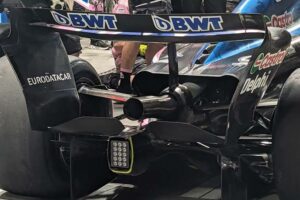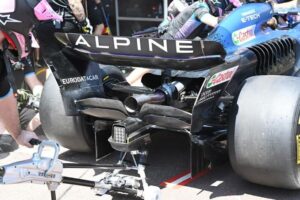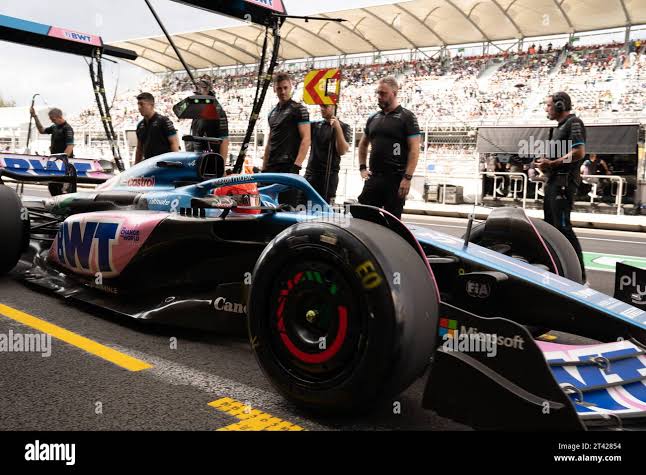Alpine has been unable to maintain a good start in this new regulatory phase having dropped to sixth place in this year’s Formula 1 constructors’ standings, compared to fourth place in 2022.While the team continued to develop solutions that could later be found on competing cars, those big ideas weren’t coherent enough to avoid ending up on their own island of points in the middle of the field. Let’s take a look at some of the finer details of the A523 and how the team has developed their package throughout 2023…Without the front brake drum in place, we can see that the A523’s caliper is positioned forward. The teardrop-shaped holes in the tub ensure that air/heat flow can flow through the assembly.

A close-up of the center floor cutouts which are very similar to the setup used by Red Bull in 2022. A close-up of the rear floor cutout, along with the tab-like fin that sits in the gap and connects to the skid under the floor. Alpine’s rear wing at the Saudi Arabian Grand Prix featured a narrow center section that was deeper than the outer sections of the wing. A large cooling vent has been inserted into the side of the engine cover to regulate the temperature. A close-up of the A523’s rear corner shows us the stepped lower edge of the rear brake duct fin, while a biplane-style girder wing layout was also used. The upper slat element of the girder wing was located further forward and below the exhaust tailpipe, while the lower element was further aft and mounted to the side of the crash structure. A look at the front floor section and floor fences, with the notable inclusion of a mud flap spoiler also on the A523. A look inside the rear brake drum shows how the team used a heat-treated shroud to cover the brake rotor. In Azerbaijan, the team cut a notch in the upper front wing flap at the inboard end to improve front-rear balance given the choices at the rear of the car. The low downforce rear wing used by Alpine in Azerbaijan featured a main plane and upper flap design in which the leading edges were pushed back from their comparable position upon impact with the endplate. The DRS actuator and connection are visible here as the cover still needs to be installed. During the Monaco Grand Prix, a small additional spoiler was installed on the trailing edge of the A523’s center pillar exhaust shroud. A close-up of some of the A523’s internal suspension components. A look at the rear of the A523 in Monaco, using a high downforce rear wing and girder wing, while also utilizing the maximum cooling gill layout on the engine cover. A great view of the rear of the A523’s front wing allows us to see some details we wouldn’t normally be aware of. A flatter, spoon-shaped rear wing was used at the Canadian Grand Prix as the team wanted to meet the demands of the circuit. This was also the first use of his open lace design. To modify the behavior of the vortex at the rear wing tip, Alpine introduced an open-ended flap solution in which the flap extended across the full span of the wing, providing additional shedding surface and modifying the cutout in the rear corner of the end plate. . Alpine switched to a tapered flap solution at the British Grand Prix, changing the interaction with the endplate (inset right) and likely achieving a more desirable washout effect. The team also played with different upper flap designs to meet the downforce requirements of different circuits, such as the wave-shaped trailing edge first seen in Hungary. A look at both front wing configurations, with the new tapered variant pictured below. A look at the A523’s starting number as the car is prepared for use in the Belgian Grand Prix and remains disconnected from its mount. A look under the skin of the A523 at the packaging of the engine and its accessories. During the Italian Grand Prix, tufts were added to the wing beam as the team wanted to collect real data on their car’s performance. Two large vortex generators were mounted on the rearview mirror housing of the Alpine A523 during the Japanese Grand Prix. A close-up of the press line in the lower half of the rear wing endplate that the team started the season with. Alpine used a low-downforce rear wing and single-element wing configuration in Las Vegas. Sensors placed on the floor in front of the rear tire to collect data for the team and help them correlate their simulation tools with information gathered from the real world.

-
-
- geometry)
- Rear wing
-
- Austria
-
- N/A
-
- Great Britain
-
- Front wing
-
- Hungary
-
- Front wing (Stepped edge)
-
- Belgium
-
- Front wing
- Floor – fences, canoe ramps and diffuser mouse hole
-
- Netherlands
-
- N/A
-
- Italy
-
- Beam wing
-
- Singapore
-
- Sidepod inlet
- Cooling louvres
- Beam wing
-
- Japan
-
- N/A
-
- Qatar
-
- Floor body (taller diffuser sidewall cutout)
- RBD lower flick
- Cooling louvres (FP1 – really for Mexico)
-
- USA
-
- N/A
-
- Mexico
-
- Deeper mid louvres
- Larger rear cooling outlet
-
- Brazil
-
- N/A
-
- Las Vegas
-
- Front wing
- Beam wing
- Rear brake duct winglets removed
-
- Abu Dhabi
- N/A



